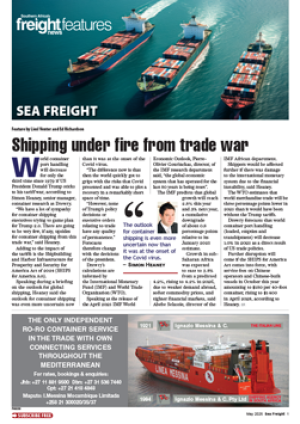The stronger rand and global competition have slowed down South Africa’s export growth. Africa specialist Duncan Bonnett of consultants Whitehouse & Associates offers an overview. SOUTH AFRICA’S trade with the rest of the continent in 2004 continued to slow, along with most other regions of the world. However, exports declined by only 0.25% from 2003, suggesting that the continent was able to absorb the strength of the rand relatively well. It should also be remembered that exporters from other parts of the globe – notably Asia, and in particular China – have begun to make inroads into many of the markets that South Africa has begun to dominate over the last decade. As the graph below illustrates, exports to the rest of Africa increased virtually unchecked from the early nineties until 2002, before falling back in 2003 and 2004. Imports, on the other hand, have surged in the last couple of years after little or no growth up until 2001. However, this is almost entirely due to increased oil and other mineral imports, and South Africa still has the capacity to import far more from the rest of the continent outside of oil and metals. Positional swops South Africa’s key trade partners in the rest of Africa remain unchanged from 2003, although there have been a couple of positional swops in terms of export destinations. Zimbabwe remains the largest export destination for South Africa, although the composition of exports to that country has changed in the last couple of years from value added products to mineral products and vegetable products. The chart below illustrates that the top destinations remain those in SADC, although exports to Kenya have begun to increase once more – with that country replacing Nigeria in fifth spot. It’s also interesting to note that Tanzania has replaced Mauritius as the sixth largest export destination in Africa. Looking through the top 15 markets it’s also noticeable that many of the countries either have or are developing extractive industries. It’s important from a South African point of view to keep close tabs on the developments in other markets from this perspective because of the opportunities for South African companies that this offers. There is a general consensus that mining and oil development across the continent will grow in importance from Mauritania on the West coast to Sudan on the East and virtually every country in between over the next decade. Opportunities for suppliers from South Africa, as exporters, investors or JV partners are thus going to increase. Beware global competition However, and it is a large caveat, companies and governments from Latin America, Asia, the USA and Europe are eyeing the same opportunities. We should never assume that this is ‘our’ domain, as the rapid spread of mining interests from Canada, Australia, Brazil, China and other countries well illustrates. Key markets such as Angola, the DR-Congo, Nigeria, Sudan, Madagascar, Mozambique, Kenya and Tanzania, to name a few, will become increasingly competitive from a supplier perspective. It’s going to require more vigilance and harder work to keep markets and develop new ones as countries from Asia look to develop Africa’s natural resources. These companies are often state-owned and have a different business model from the traditional Western concept, bringing virtually all of the technological and physical requirements from their home countries, including the labour in some cases.
